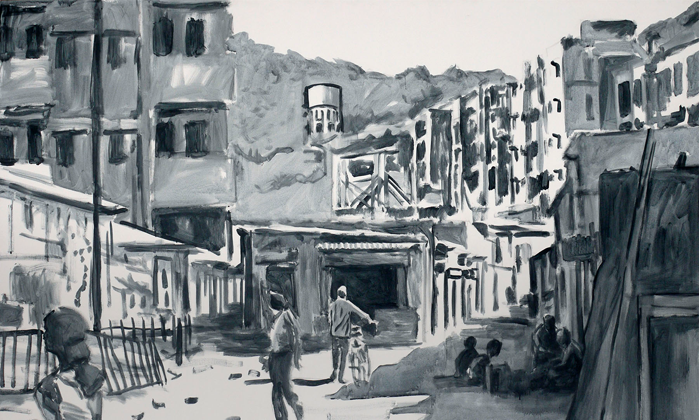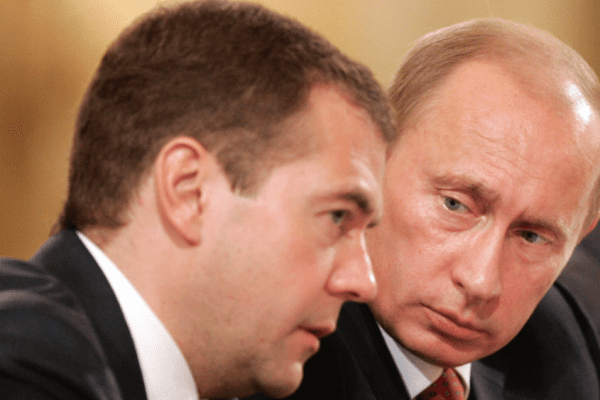Buildings often found on the fringes of many towns and cities, as I realised later—buildings left unfinished because they were started without adequate clearances, or because the fortunes of the entities constructing them suffered a downswing, or because the project itself got embroiled in a dispute, writes Aritra Bhattacharya.
It seemed to take me away, this painting (above), to another time, another place.
Is this Bombay, I wondered? Some part of the city, along the Harbour Line railway network, near the docks?
Sewree perhaps? Or Sandhurst Road? Where some parts of Fort Stikine—burning infernos—landed when the ship blew up on the docks of the city in 1944? Where a large part of the city’s workforce lives, in cramped, dilapidated buildings, away from the romantic gaze of Bollywood and contemporary popular culture?
Perhaps.
But the painting took me back, much more strongly, to my adolescence. To faraway lands, areas outside the purview of ‘safety’. Areas where I would go once in a while, with friends, on the sly.
I used to live in Asansol, then a small town along the coal belt of Eastern India. Also the site of a steel factory called Indian Iron and Steel Company (IISCo). And close to the first of India’s Nehruvian temples—the Maithon dam that was part of the Damodar Valley Corporation (DVC).
The river Damodar flowed along the periphery of the town—often demarcating it from the ‘other’—they were Santhals, I was told, who would come to work in the town’s roads, gardens, homes and construction sites. Every evening, they would take a boat across the river, or wade through if it was the summer months, to reach their homes on the other side—the side beyond the pale of gentility and civilisation. I saw them make this journey on many occasions, when I would sit by the river with friends, in the twilight hours, before and after dark. It was these visits and the sights that the painting took me back to.Who had constructed those buildings? Perhaps, it was the IISCo, or the DVC, that wanted to house its middle class officials in flats by the riverside. Those unfinished, ghostly buildings demarcated the peripheries of town and village, safety and danger, us and the ‘other’.Along the way to the riverbank, near the cremation ground, were a bunch of buildings. Multi-storied, half-finished, with shrubs growing all around them. They had no doors or windows—just the framework, which made it seem like someone had completed the construction in a hurry and forgotten to affix the essentials. Nobody stayed in those buildings; they were abandoned, eerie. Their interiors appeared dark, dank from the outside, even when the sun was beating down on the tar road just beside them.
![]()
‘The Emergent..’ 2012
It is those buildings that Sudhir Patwardhan’s painting (Revisiting Pokhran) reminded me of. Buildings often found on the fringes of many towns and cities, as I realised later—buildings left unfinished because they were started without adequate clearances, or because the fortunes of the entities constructing them suffered a downswing, or because the project itself got embroiled in a dispute.
Such buildings are standing reminders of the limits of the discourse of development. They reveal and lay bare what cannot be concealed—the dreams of its would-be middle class occupants that came crashing down, the misery of the earlier occupants of the land who were delegitimised in one stroke, and who continue to occupy its fringes, staying in rickety, makeshift houses, trading in knick-knacks.
“The river Damodar flowed along the periphery of the town—often demarcating it from the ‘other’—they were Santhals, I was told, who would come to work in the town’s roads, gardens, homes and construction sites.”
Patwardhan’s painting also had these characters—the man on the road or with the cycle, near but not inside the big building. The big buildings themselves appeared dark and dank, windowless and eerie, despite the sunlight beating down on them.
To me, at that point, the painting seemed to tell the story of ‘development’; like the building in the work, the painting seemed to reveal what a galaxy of words cannot.
I moved closer to the work, and the brushstrokes became apparent. Were the brush strokes quick and fervent, or did they appear so given my dispensation? In any case, even from close, it appeared unfinished. But complete.
I moved closer to look at the title of the work. ‘Revisiting Pokharan’.
Pokharan! The place where the Buddha is supposed to have smiled; the place that is supposed to have facilitated the entry of India into the nuclear club; the place that was the launch pad of nuclear nationalism.
What do we make of the fact that the artist chose to title this work—comprising ghostly, unfinished buildings signifying decadence and morbidity perhaps—‘Revisiting Pokharan’?
![]()
‘The Residual..’ 2009
Is this a pointer to the hollowness of the nuclear discourse, for what did the people populating the fringes—or the aam aadmi separate from the Congress’ or Kejriwal’s construct—gain out of India being recognised as a nuclear power in the world at large? The communities who put their lives at peril, to facilitate a nuclear test, or in the more contemporary times, a nuclear power plant, remain neglected, their miseries unrecognized by a state that wants to champion the cause of progress and development. They are faceless, like the characters in ‘Revisiting Pokharan’. Is the work a nudge towards recognising the pitfalls of this nuclear nationalism, never mind the nations that have been ripped apart in trying to erect its citadel?
I look at other works in the show titled ‘Route Maps’. ‘The Emergent’ and ‘The Residual’ seem to underline the anxiety referred to above rather well.
‘The Emergent’ features a blue high-rise in the midst of smaller, more humble structures. This could be the mill district of the country’s financial capital, in whose suburb the painter lives and works.
This could also be a vignette out of any other megacity, from an area that is seeing a sudden invasion of capital into people’s lifespaces. ‘The Residual’ features what looks like an abandoned railway signal cabin, like the ones close to the peripheries of big railway stations; the work seems to point to what’s left behind, what will at some point in the future be the ground for The Emergent.
‘Blue Man’, another work in the show, features a faceless, seemingly male human form in what is perhaps the night. This darkness, and the glass casing the painting is enclosed under allows it to reflect the image of the viewer, or other works in the show. It seems more like a mirror, this work—but a mirror that reveals much more about what’s in front of it than is generally the case. ‘Blue Man’ has the ability to, partly, morph and become anything that the viewer standing in front of it wants to see within its frame. This is perhaps like the battery of words that India uses to announce its position in the world—words like development, progress, growth; words that are so plastic that one can make them mean anything one wants, while never being able to see through what it actually means. Much like the blue in the ‘Blue Man’.
‘Route Maps’, a solo exhibition of Sudhir Patwardhan’s work, is on view at The Guild Art Gallery, Mumbai (http://www.guildindia.com/home.htm) till December 11.


